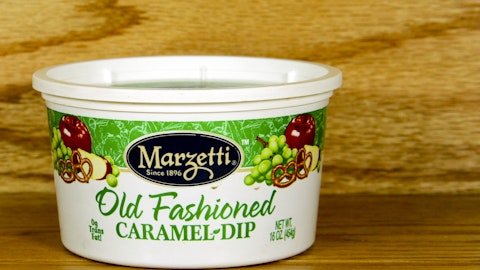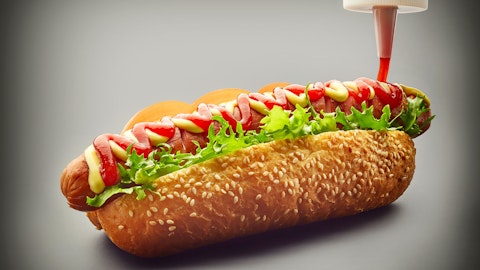So as we bring more items, it gives us more scale and more relevance with our retail partners. Our retail team has stepped up and they’re executing well. So I think Tom and I and the rest of the leadership team would feel comfortable that, hey, if we had the right partner coming on board, we could support them and continue to focus on driving growth on our existing brands. I mean, one of the milestones that we hit this most recent period is that Chick-fil-A sauce entered into the top 10 of all SKUs in the sauces category and when I’m talking the top 10 I’m talking Hellmann’s mayonnaise is on that list, some of the Heinz ketchup items are on that list and we still believe that that brand — even though between dressings and sauces now and retail sales is about $200 million at sales, there’s a lot of chicken left on that bone.
There’s a lot of room for us to continue to grow.
Todd Brooks: Well put. Just two quick follow-ups. Is Subway or any of the partners selling product in restaurant? And is that — would that, if they were doing that, show up in food service? Or would you take that back to the retail side of the operation? And then, Tom, where you talked about Horse Cave running full out for food service, have we started to need to go back to kind of those co-manufacturer arrangements that we had leading up into Horse Cave to meet the demand on that side of the house. Thank you all.
Dave Ciesinski: Yes. On the co-packer front, not really. What we’re focused on here is, I think the decisions when we’re investing, I think what Tom is trying to share is, a brownfield or a greenfield decision is — you’re talking two or three years. These are long-term things and it takes time to bring them to fruition. So just as a matter of keeping pace with the lead times that are required, you begin to think about these things earlier than you might think. And I think that’s the point he’s trying to make. So we’re not trying to give the impression that we’re pinched on capacity, because that’s not the case. They are just decisions that require time to make sure you get the right place, it’s designed the right way, and if it’s a new site, you work with the government on things like incentives and stuff like that.
So I think what Tom is trying to foreshadow is that, as we continue to see growth in recent periods as we continue to project for growth, it’s going to necessitate us to think about another site, but also kind of our network more broadly in terms of where we want that site to be to make sure that it’s maximizing utility and profit.
Todd Brooks: Thank you. [Operator Instructions] Please stand by for our next question. Our next question comes from the line of [Scott Mox] (ph) with Jefferies. Your line is open.
Unidentified Analyst: Hey, good morning, guys. This is Scott here on for Rob.
Dave Ciesinski: Good morning.
Unidentified Analyst: Thanks for taking my question. Just want to come back to the Subway and Texas Roadhouse items you launched [indiscernible]. Just wondering how those are performing relative to your initial expectations? And then secondly to that, how some of the other licensed brands are performing relative to expectations for where they are in their lifecycle?
Dave Ciesinski: Yes, so maybe starting first with Subway and Texas Roadhouse, Scott, in the period we had very modest sales in Q3. So I would tell you, it’s certainly projecting off of Q3 results too early to say one way or another to look at the data. I would tell you that we’re building distribution in line with our expectations, but it’s a slow build from customer to customer. It doesn’t happen, as you know, in one overnight tranche. So I would tell you we’re just taking an optimistic wait and see of you and our sales team is aggressively working with our retail partners to make sure that we’re getting the items and the right number of phasing and the right place on the shelf. Now, if you just ask the bigger question, which is around how do we feel about the performance of these items and the long-term opportunity?
We continue to be very bullish, really, across all of our licensed partners. I mentioned that if you look at Chick-fil-A, one of the important points we would point to, on a 52-week basis today, Chick-fil-A’s household penetration is only 10.5%. Our own New York Bakery garlic bread is almost a 19% household penetration. So we feel like there continues to be a lot of opportunity to drive household penetration. If you look at the number of consumers that visit Chick-fil-A restaurants, I mean, it’s probably three times what that number is, if not higher than that. So again, just taking that brand close in, we believe there’s plenty of room to continue to build household penetration on the core. We think that Chick-fil-A brand has big shoulders and there are other sauces and dressings that we could launch behind that.
You move around the portfolio, and you talk about Olive Garden. Really early days, we launched into Italian. Then we moved into ranch. As we entered into ranch, we were able to get more facings on the shelf, which improved velocity for all of the items. We came out behind that with Caesar, which has performed very, very well. And then most recently out with a Balsamic. So in some brands, it’s just driving penetration and getting sizing right. I think that’s the case with Chick-fil-A, because that brand just has big shoulders, like a Heinz Ketchup, for example. In the case of an Olive Garden, the way you manage a brand like that is, you drive assortment. And we think that the Olive Garden brand continues to have more room to continue to grow as well.
Buffalo Wild Wings, it’s kind of a combination of the two. We think there’s more different flavor dimensions that we can go out with, but most recently now we’re taking some of their best selling items and we’re converting those to larger sizes. So whether Tom or me or any one of a number of people on our team, we all grew up managing big brands. I spent time at Heinz and Kraft and worked on Blue Box and Heinz Ketchup. And most of our team comes from bigger companies like that. And in essence, what we’re doing is we’re using the same sort of playbook tailored for each of these brands to help them uniquely grow. But with our existing partners, we think that there’s plenty more room to continue to grow.
Unidentified Analyst: That’s helpful. Thank you. And then just as a second question, I know there’s been a lot of discussion around food service and just general macro environment impacting, obviously, restaurants. I wonder I you talk about your outlook maybe for the next six months or the balance of the year. I think we’ve heard from some others that they expect the consumer to improve a little, feel a little less pressured later in the year. I’m wondering if you guys kind of feel the same and any general thoughts you may have, that’d be great.
Dave Ciesinski: Yeah, we expect our algorithm to remain essentially the same, but the ability to deliver both top line growth, sales growth, and volumetric growth on both sides of the business. And I don’t know if you want to provide any other textures than that.
Tom Pigott: Yes, I think where we sit in the marketplace, as Dave hit on earlier, there’s certainly some concern about the consumer. I think when we look at our broader portfolio, the QSR exposure we have, particularly with Chick-fil-A, we feel very good about that. And then on the retail side, as you saw this last quarter, we reinvested a bit of trade. We were able to drive more volume growth, protect our position in the marketplace, grow penetration. And so, I think overall we’re responding to the softness that a lot of folks see and I think we’re well positioned to continue to do it. So that’s where I think Dave and I both feel we can continue the algorithm through Q4 and into next year.
Unidentified Analyst: All right. Much appreciated. Thanks much.
Dave Ciesinski: Of course.
Operator: Thank you.
Dave Ciesinski: Maybe the last thing that I’ll offer to that question is sort of how we’re thinking about Q4 and the next fiscal year. It’s really focusing on three key things. Consumer relevant innovation because in a great economy it’s important and in an economy that’s slightly more challenging, it’s equally important. So consumer relevant innovation. Second point is just smart cost management. And then finally just good execution and avoiding unforced errors. So the team is pretty narrowly focused on those three items. And if we can just continue to execute, we’re bullish about the outlook.
Operator: Thank you. I’m showing no further questions in the queue. I would now like to turn the call back over to Dave for his closing comments.
Dave Ciesinski: Very good. Well, thank you. And thank you to everybody that joined on the call. We look forward to being with you again in August where we take you to our Q4 results and talk a little bit about our outlook for the next fiscal year. We hope you guys have a great rest of the day.
Operator: Ladies and gentlemen, this concludes today’s conference call. Thank you for your participation. You may now disconnect.
Follow Marzetti Co (NASDAQ:MZTI)
Follow Marzetti Co (NASDAQ:MZTI)
Receive real-time insider trading and news alerts





